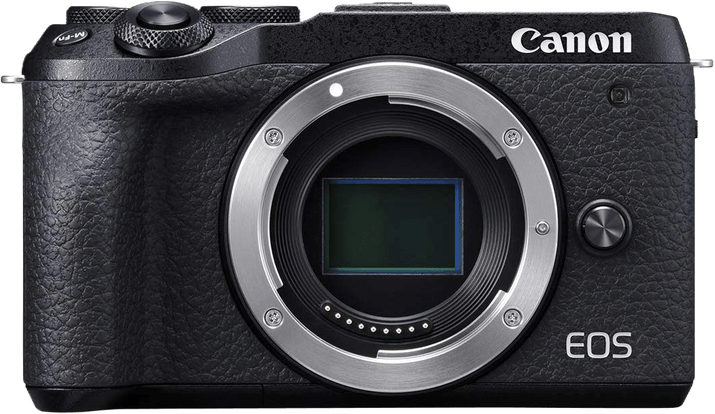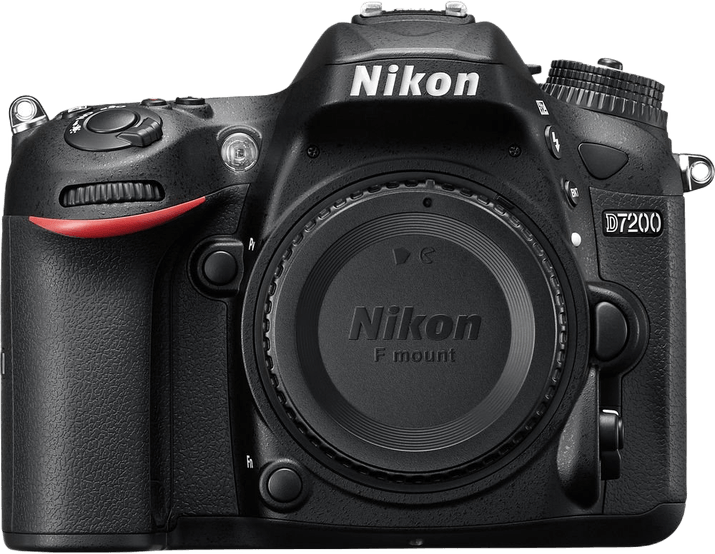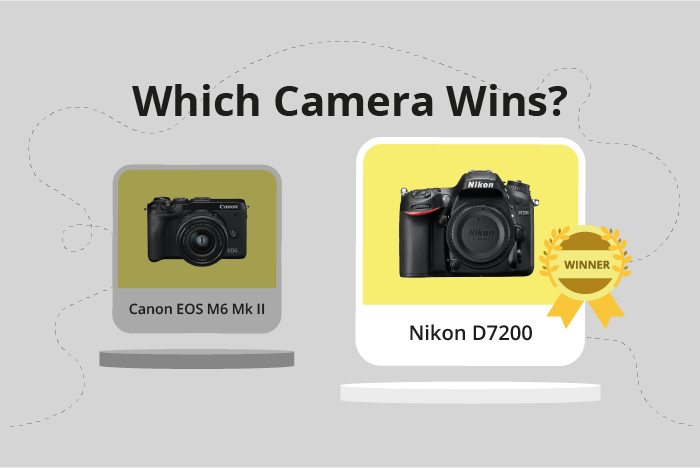Canon EOS M6 Mark II vs Nikon D7200 Comparison
Canon EOS M6 Mark II

Nikon D7200

The Nikon D7200 outperforms the Canon EOS M6 Mark II with a score of 68/100 compared to 63/100. Both cameras share similarities such as their release years, 2015 and 2019 respectively. However, significant differences set them apart.
The Canon EOS M6 Mark II is a mirrorless camera, which makes it lighter (408g) and more compact (120 x 70 x 49mm) than the Nikon D7200, a DSLR camera weighing 765g and measuring 136 x 107 x 76mm. Additionally, the Canon model has a lower launch price of $850, compared to the Nikon’s $1200.
Despite these advantages, the Nikon D7200 still earns a higher score due to its overall performance and features. The DSLR camera type offers better image quality and a more extensive range of lenses. This makes the Nikon D7200 the better option for professional photographers, while the Canon EOS M6 Mark II is more suited for casual users seeking a lightweight and budget-friendly camera.
Canon EOS M6 Mark II vs Nikon D7200 Overview and Optics
The Nikon D7200 outperforms the Canon EOS M6 Mark II in optics, scoring 71/100 compared to the Canon’s 62/100. Both cameras share several specifications, such as the CMOS sensor type, APS-C sensor size, and the absence of image stabilization. Despite these similarities, the Nikon D7200 surpasses the Canon EOS M6 Mark II in certain aspects, while the Canon holds its own advantages.
The Nikon D7200’s superior optics score results from its higher DXOMARK sensor score of 87, compared to the Canon’s 58. This difference implies that the Nikon D7200 provides better image quality and low-light performance. The Nikon D7200 also has a more versatile lens mount, the Nikon F DX, which is compatible with a wider range of lenses than the Canon EF-M mount.
On the other hand, the Canon EOS M6 Mark II boasts a higher megapixel count of 33, compared to the Nikon’s 24.2. This feature allows the Canon to capture more detail and produce larger prints. Additionally, the Canon EOS M6 Mark II has a faster shooting speed of 14 frames per second, doubling the Nikon’s 6 frames per second. This advantage makes the Canon more suitable for capturing fast-moving subjects.
Despite the Nikon D7200’s higher optics score, the Canon EOS M6 Mark II holds its own with its higher megapixel count and faster shooting speed. While the Nikon D7200 offers better image quality and lens compatibility, the Canon EOS M6 Mark II excels in capturing detailed images and fast action. Ultimately, the choice between these cameras depends on the specific needs and preferences of the photographer.
Canon EOS M6 Mark II vs Nikon D7200 Video Performance
The Canon EOS M6 Mark II outperforms the Nikon D7200 in video capabilities, scoring 91 out of 100 compared to the D7200’s score of 70. Both cameras share the useful feature of built-in time-lapse functionality, making them suitable for capturing dynamic scenes over an extended period.
The EOS M6 Mark II excels in video quality with a maximum resolution of 4K, significantly higher than the D7200’s Full HD resolution. This results in sharper and more detailed footage, allowing for better post-processing and editing possibilities. Additionally, the M6 Mark II offers a maximum video frame rate of 120fps, double the D7200’s 60fps limit. This higher frame rate enables users to capture smoother slow-motion footage, providing more creative options in video production.
While the Nikon D7200 trails in video quality and frame rate, it still offers solid performance for those not requiring 4K resolution or higher frame rates. Its Full HD resolution is suitable for many video projects, and the 60fps frame rate is sufficient for most casual users. However, it does not match the M6 Mark II’s capabilities for professional or advanced video enthusiasts.
Comparing the video capabilities of these two cameras, the Canon EOS M6 Mark II is the clear winner, boasting superior video resolution and frame rates. The Nikon D7200 remains a viable option for those with less demanding video needs, but for those seeking top-quality footage and the ability to capture smooth slow-motion, the M6 Mark II is the better choice.
Canon EOS M6 Mark II vs Nikon D7200 Features and Benefits
The Canon EOS M6 Mark II emerges as the winner with a feature score of 70/100, while the Nikon D7200 trails behind with a score of 59/100. Both cameras share certain specifications, such as a screen size of over 3 inches, screen resolutions over 1,000,000 dots, and the absence of GPS. Additionally, both cameras offer Wi-Fi connectivity.
The Canon EOS M6 Mark II outshines the Nikon D7200 with its touchscreen, flip screen, and Bluetooth capabilities. The touchscreen allows for seamless navigation and quick adjustments to settings. The flip screen is beneficial for capturing images and videos from various angles, which is useful for vloggers and content creators. Bluetooth connectivity enables easy transfer of images and videos to other devices, making the M6 Mark II more versatile and user-friendly.
On the other hand, the Nikon D7200 boasts a slightly larger screen size of 3.2 inches and a higher screen resolution of 1,228,800 dots. However, the absence of a touchscreen and flip screen limits its usability compared to the Canon EOS M6 Mark II. The D7200 also lacks Bluetooth connectivity, which can be seen as a disadvantage for users who value seamless device integration.
In comparing the features of both cameras, the Canon EOS M6 Mark II stands out as the superior option due to its touchscreen, flip screen, and Bluetooth capabilities. The Nikon D7200 has a larger screen and higher resolution, but the absence of key features found in the M6 Mark II makes it less versatile and user-friendly. As a result, the Canon EOS M6 Mark II is the better choice for users seeking a versatile and easy-to-use camera.
Canon EOS M6 Mark II vs Nikon D7200 Storage and Battery
The Nikon D7200 outperforms the Canon EOS M6 Mark II in storage and battery with a score of 79/100, while the Canon scores 35/100. Both cameras accept SD, SDHC, and SDXC memory cards. However, the Nikon D7200 has an advantage with two memory card slots, compared to the Canon’s single slot. The Canon EOS M6 Mark II is compatible with UHS-II cards, providing faster read and write speeds.
In terms of battery life, the Nikon D7200 lasts significantly longer with 1110 shots per charge, while the Canon EOS M6 Mark II manages 305 shots. The Nikon uses an EN-EL15 battery, and the Canon uses an LP-E17 battery. A notable feature of the Canon camera is its USB charging capability, which the Nikon lacks.
Considering these factors, the Nikon D7200 offers superior storage and battery capabilities. The Canon EOS M6 Mark II’s advantage lies in its USB charging and UHS-II compatibility. Ultimately, the choice depends on individual preferences and priorities.
Canon EOS M6 Mark II vs Nikon D7200 – Our Verdict
Are you still undecided about which camera is right for you? Have a look at these popular comparisons that feature the Canon EOS M6 Mark II or the Nikon D7200:

